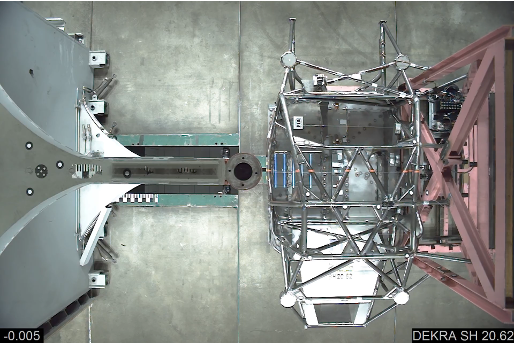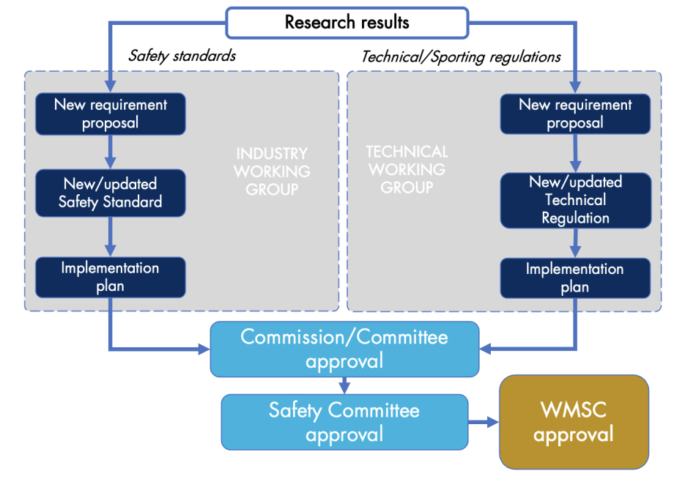The third annual FIA Safety Week got underway in Geneva with Safety and Technical Departments leaders detailing how the Federation’s intensive safety research and development not only leads to significant improvements in competitor protection but can, in the case of the World Rally Championship, also pave the way for a new era of better competition.
The week-long series of seminars began with Deputy Safety Director and Head of Research and Vehicle Safety Marco Petrilli explaining how research becomes regulation.
“We can identify three main types of trigger for safety research,” he said. “The first is accident investigation. We constantly monitor what’s happening on track and on stage in terms of accidents to ensure what we have deployed is working and then to understand where we can improve. The second trigger is new technology, for example hydrogen power. We are asked to understand how this technology can be deployed and how we might build up technical and safety regulations for a safe deployment of a hydrogen championship. Finally, a new car definition is another trigger for a safety research project.”
He went on to explain how research results then feed into new or revised safety standard or safety regulations, with proposals first proceeding to FIA Commission or Committee level, before reaching the FIA Safety Committee, which then sends the proposed standard or safety regulation to the World Motor Sport Council for final approval.
“Our research is purely data driven,” he added. “Every decision we take, every deliverable deployed in the different championships, is based on an engineering approach. There is never a subjective or point-of-view assessment. Everything is analysed and investigated in collaboration with the relevant stakeholders and agreed with them, but always based on an engineering approach. And once a project is completed, then through a clear regulatory framework, it’s deployed.”
The Deputy Safety Director then pointed to safety specification of Rally 1 cars as an example of how data-driven research led not only to vastly improved safety for competitors but also established a framework around which the sport’s more competitive, cost-effective and flexible WRC27 cars could be built.
“Before 2021, in WRC, the safety structure consisted of two main parts, the body shell, which was based on a homologated series car and the safety cage, but in 2021 we steered completely away from that approach,” Petrilli said. “We were asked to define new design requirements for a tubular frame – starting from scratch and keeping in mind the goal to always improve in terms of safety.”
The result was an intense, far-reaching safety research project that in the end resulted in a tubular frame that reduced the level of intrusion in side impacts by more than 50%, by more than 70% in frontal impacts and which increased energy absorption in roof impacts by a massive 115%.
Commenting on the improvement, FIA Technical Engineering Director Thomas Chevaucher said: “We moved from one of the strongest cars to date to a real evolution in terms of safety and the past four seasons have shown that the tubular frame proved to be a clear improvement.”
Chevaucher also pointed to a number of learnings from the tubular frame that will have a positive impact on competition when the WRC moves to a new, era-defining set of regulations in 2027.
“It will help sporting equity,” he explained. “How? Because in the past all cars were linked to a road legal body shape and that means the size of your car, the overall dimensions are linked to that. If you are a manufacturer and you don’t have that in your portfolio, you can’t enter the top class of rallying.”
The tubular frame, he said, allows for greater design flexibility, meaning that manufacturers will have more freedom to design cars that suit their marketing needs, thereby encouraging wider entry to the championship. The body shells of the cars can be scaled, allowing models from different segments, such as hatchbacks, saloon cars and SUVs, the possibility to be run in competition.
The tubular frame is also set to provide a more adaptable platform for new technologies and while 2027 will launch with sustainably fuelled combustion power, the platform is flexible enough to allow for future regulatory evolution.

Finally, he added that the tubular frame provides the FIA with an important opportunity to cascade safety improvements to the wider off-road world.
“When you see a big improvement in terms of safety from technological change, we want to implement this in as many cars as possible, because we want to protect as many crews as we can,” he said. “That is clearly what we want to do with the new 2027 World Rally Car regulations.
“In 2027 we will move away from a concept of ‘Rally 1’ and Rally 2’ and into a WRC27 regulation that aims to attract more cars into the top category,” he concluded. “All these cars will be based on that same tubular frame. This is a step-by-step process. The further steps, going to Rally 4 and Rally 5 is something that will be discussed. There is also potential for cross-over with World RX, taking that safety improvement across and allowing teams or manufacturers to run cars in both categories.”
World Rally Championship
SafetyRally SafetyWRCRegulations SEASON 2025SafetyRallies1SafetyWorld Rally ChampionshipRalliesSEASON 2025SafetyRally SafetyWRCRegulations00Wednesday, February 5, 2025 – 11:46amWednesday, February 5, 2025 – 11:46am
SEASON 2025SafetyRallies1SafetyWorld Rally ChampionshipRalliesSEASON 2025SafetyRally SafetyWRCRegulations00Wednesday, February 5, 2025 – 11:46amWednesday, February 5, 2025 – 11:46am
Source : Fia











